Reclaimed areas
| |
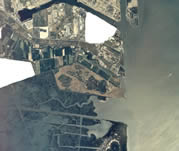 |
|
|
|
|
|
| |
| |
|
Before
reclaimed areas...
After the Second World War the second industrial area of Porto Marghera
began to be built. Since then a period of expansion started, which led,
in 1960, to the realisation of new structures: the first was the excavation
of the canal that links the port of Malamocco to the area of S. Leonardo
in Marghera, which allowed oil tankers to enter the industrial area (from
Rallo G., “Guida alla natura nella laguna di Venezia – Itinerari,
storia e informazioni naturalistiche” ”, 1996).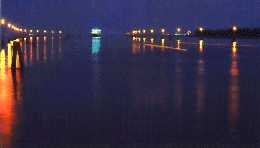
The realisation of Oil tanker canal caused the cancellation of several
important historical traces as San Marco's old embankment, a massive work
built between 1534 and 1543 to defend the city from the flooding of the
Piave (from Caniato G., “L’organismo delicato: il governo
idraulico e ambientale” in “La laguna di Venezia”, 1995).
The building of the first part of this embankment had already begun in
1327 between San Marco in Bocca Lama and Campalto with the aim of diverting
the fresh waters of the Bottenigo and of the Muson from the central lagoon.
One more evidence of the Venetian history disappeared because of the realisation
of the Oil tanker canal (from Zanetto G., Calzavara A., “La laguna
tra residualità e modernizzazione”, in “La laguna di
Venezia”, 1995) is represented by the island of San Marco in Bocca
Lama where an old church built in 960, later substituted by San Marco's
church in 1320, was located.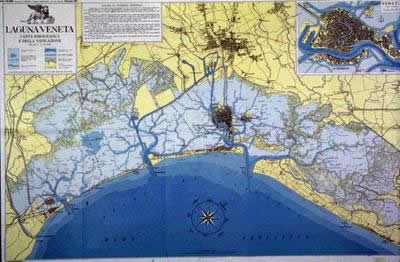 After diverting the Brenta, which threatened the surviving of the island,
the activity started again and the island began to represent an important
point of reference for those who, after the closing of the inlet of Fusina,
were forced to sail through that area of the lagoon.
After diverting the Brenta, which threatened the surviving of the island,
the activity started again and the island began to represent an important
point of reference for those who, after the closing of the inlet of Fusina,
were forced to sail through that area of the lagoon.
During the plague of 1348 the island was used as a cemetery for the great
number of victims of the epidemic (from “Relitti
dalla laguna di Venezia”, articolo reperibile nel sito internet
di Assonet, Archeologia Subacquea Speleologia
Organizzazione Network; from Masiero F.,“Le isole delle lagune venete
– Natura, storia, arte, turismo”, 1981).
Before the Oil tanker canal was realised in the zones where the reclaimed
areas are now located there were once saltmarshes and shallows marked
by a network of
canals.
The realisation
of reclaimed areas
Starting from 1963 the material coming from the excavation of the Oil
tanker canal began to be employed for the realisation of some artificial
islands on which the third industrial area was to be built: that project
involved silting up of all the saltmarshes and fishfarms of the Lagoon
from Marghera to Chioggia, where the new industrial area was to be built.
The work was first suspended in 1969 and in 1973 this project was blocked
for good by the Special Law for Venice.
However by that time three areas had already been realised: the "A",
"B" and "D-E" reclaimed areas at an average height
of two metres above sea level, for an overall surface of 11.36 km, created
by employing about 20 millions cubic metres of material.
The building of the reclaimed areas prevented the expansion of the tidal
wave, with consequences both on the height of the high water and on
the effectiveness of water change. Some interventions for the restoration
of the old hydrodynamic conditions were made by Consorzio Venezia Nuova
by carrying out the excavation of the canals of Taglio Vecchio and Mattoni
in the "D-E" reclaimed area, and of the canals of Volpego
and Fiumesino, which now link the Lake of Teneri to the Lagoon, in the
"B" reclaimed area.
The
"A" reclaimed area: flora and fauna
The "A" reclaimed area is located west of the mainland, near
Malcontenta, and it covers a surface of 155 hectares. As it is not linked
neither to the lagoon canals nor to other water courses, only rainwater
can be found there.
Within this reclaimed area, because of the embankment, a part of the lagoon
canal named the Taglio dell'Aversa has been completely isolated by the
Lagoon.
The part of the reclaimed area facing the mainland is flat and has a half-submerged
vegetation, also influenced by the presence of two rainwater chiari.
The banks are covered with common reed (Phragmites
australis), sea rush (Juncus
maritimus), and with narrow leaf cattail (Typha
angustifolia).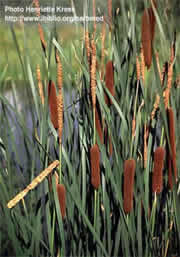
In the internal border there are the tick quackgrass (Thinopyrum
pycnanthum), the orchardgrass (Dactylis
glomerata) and the french tamarisk (Tamarix
gallica).
There are several species of nesting,
migratory
and wintering
water birds distributed in the three main biotopes of the reclaimed area:
· gently sloping surface with more elevated slimy-sandy relieves:
kentish plover (Charadrius
alexandrinus), little riged plover (Charadrius
dubius), greater short-toed lark (Calandrella
brachydactyla);
· half-submerged tracts and marginal zones: spotted crake (Porzana
porzana), common moorhen (Gallinula
chloropus), stilt (Himantopus
himantopus);
· embankments and banks of the closed internal canal: little grebe
(Podiceps
ruficollis ruficollis), little bittern (Ixobrychus
minutus), mallard (Anas
platyrhynchos), common coot (Fulica
atra), cuckoo (Cuculus
canorus) (from Rallo G., “Guida alla natura nella
laguna di Venezia – Itinerari, storia e informazioni naturalistiche”,
1996; from Calzavara D., “Le casse di colmata della laguna media,
a sud di Venezia – VII. Ipotesi per lo studio fitosociologico della
cassa D-E”, 1980).
The
"B" reclaimed area: flora and fauna
The "B" reclaimed area is located in the middle of the central
Lagoon and it can be reached only by boat. It has a surface of 385 hectares.
It is completely covered with re-colonising vegetation: above all with
white poplar (Populus alba), the Lombardy poplar (Populus
nigra), several species of willows (Salix spp.) and with
french tamarisk.
As in the other reclaimed areas, here one can find the glasswort (Salicornia
fruticosa), sand couch, common reed and narrow leaf cattail,
the last two especially where temporary water ponds and freshwater "chiari"
of meteoric
origin are present.
Towards the Teneri Lake the stilt, the Montagu's Harrier (Circus
pygargus) and the great reed warbler (Acrocephalus
arundinaceus) are present among others.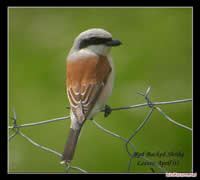
In the wooded area the red-backed shrike (Lanius
collurio) and the eurasian penduline-tit (Remiz
pendulinus) find the right habitat for nesting (from Rallo
G., “Guida alla natura nella laguna di Venezia – Itinerari,
storia e informazioni naturalistiche”, 1996; from Calzavara D.,
“Le casse di colmata della laguna media, a sud di Venezia –
VII. Ipotesi per lo studio fitosociologico della cassa D-E”, 1980).
The
"D-E" reclaimed area: flora and fauna
The "D-E" is the widest (752 hectares) of all the reclaimed
areas and it is characterised by several
ecological niches.
Inside of it there are numerous backmarshes made up mainly of rainwater,
even if with high tide they can be made of brackish waters too.
It is located in the middle of the central Lagoon.
Its vegetation has evolved towards a less and less halophilous
kind of inland flora.
Vegetal groupings are still evolving and cannot be assimilated to associations.
In this reclaimed area too, one can find the narrow leaf cattail, the
common reed, the sea rush, the glasswort, the puccinellia (Puccinellia
palustris), poplars, french tamarisk and the wigeongrass
(Ruppia
maritima).
As far as the avifauna is concerned, here, besides the species found in
the other environments, some rare species can be seen as the purple heron
(Ardea
purpurea), which nests in the bed of reeds (from Rallo
G., “Guida alla natura nella laguna di Venezia – Itinerari,
storia e informazioni naturalistiche”, 1996; from Calzavara D.,
“Le casse di colmata della laguna media, a sud di Venezia –
VII. Ipotesi per lo studio fitosociologico della cassa D-E”, 1980).
In the reclaimed areas the highest salinity
is found in the lowest soils, while it decreases at upper levels and it
can even disappear in the mesophyll grasslands.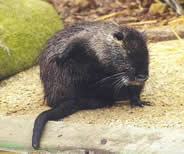
Vegetation is continuously evolving towards less and less halophilous
characteristics and this process, slower in the lower parts, has almost
come to its conclusion in the upper zones even if in the last few years
this trend has been reversed because of the expansion of the lagoon due
to the lowering of the coast (positive bradyseism)
(from Pignatti S., “La vegetazione alofila della laguna di Venezia”,
1966).
In the "B" and "D-E" reclaimed areas,
besides the presence of the avifauna, other animals have been noticed:
the grass snake (Natrix
natrix) and the nutria (Myocastor
coypus), even if not in an elevated number, are present.
Zonation
of the reclaimed areas
Depending on the characteristics of the vegetation, each of the reclaimed
areas can be divided into three areas:
a) areas scantily involved in the land reclamation works and that have
therefore kept their original features, represented by halophilous vegetation
and by the presence of "chiari" made of brackish water;
b) wooded areas, in which specimens of poplar, willow-tree, birch are
present: these are the most internal and elevated zones;
c) the remaining areas represent the widest zone: the vegetation in these
areas is of mesophyll kind (for example Agropyron pungens), while
in the most low-lying zones the rush (Juncus sp.) and the common
reed (Phragmites australis). Here the "chiari" are
characterised by low salinity (< 10%) which allows the development
of the bed of reeds.
The reclaimed areas, for their abundance of ornithological
species, are considered nationally important biotopes; some specimens
of bittern and several individuals of Airone rosso included in the Annex
1 of the EEC directive 79/409 (“Birds
Directive ”)live there.
|



